c++简单程序设计 实验一
2019-03-14 00:48 孙乾(小U) 阅读(556) 评论(5) 编辑 收藏 举报实验内容:
2-28
实现一个简单的菜单程序,运行时显示“Menu:A(dd) D(elete) S(ort) Q(uit),Selete one:”提示用户输入。A表示增加,D表示删除,
S表示排序,Q表示退出。输入为A、D、S时分别提示“数据已经增加、删除、排序。”,输入Q时程序结束。
以下分别是我用两种语句写出的简单菜单程序:
- if...else语句
-
#include<iostream> #include<cstdlib> using namespace std; int main() { char option; while(1) { cout<<"Menu:A(dd) D(elete) S(ort) Q(uit),Selet one:"; cin>>option; if(option=='A') { cout<<"data has added"<<endl; continue; } else if(option=='D') { cout<<"data has deleted"<<endl; continue; } else if(option=='S') { cout<<"data has sorted"<<endl; continue; } else if(option=='Q') break; else { cout<<"There is a mistake in the input,please re-enter."<<endl; continue; } } }
- switch语句
-
#include<iostream> #include<cstdlib> using namespace std; int main() { char option; while(1) { cout<<"Menu:A(dd) D(elete) S(ort) Q(uit),Selet one:"; cin>>option; switch(option) { case'A':cout<<"data has added "<<endl;break; case'D':cout<<"data has deleted"<<endl;break; case'S':cout<<"data has sorted"<<endl;break; case'Q':exit(0);break; default:cout<<"There is a mistake in the input,please re-enter."<<endl; } } return 0; }

2-29
用穷举法找出1~100间的质数并显示出来。
这个程序我用了while和for循环两种实现方法。算法设计:用一个数除以2到sqrt这个数,其中只要有一个能被整除,那这个数就不是素数,反之是素数。具体代码如下:
- while循环
-
#include<iostream> #include<math.h> using namespace std; int main() { int i,j,k,sign; i=2; while(i<=100) { sign=1; k=sqrt(i); j=2; while(j<=k) { if(i%j==0) { sign=0; break; } j++; } if(sign) cout<<i<<endl; i++; } }
- for循环
-
#include<iostream> #include<math.h> using namespace std; int main() { int i,j,k,a; for(i=2;i<=100;i++) { a=1; k=sqrt(i); for(j=2;j<=k;j++) { if(i%j==0) { a=0; break; } } if(a) cout<<i<<endl; } }
运行结果如下:
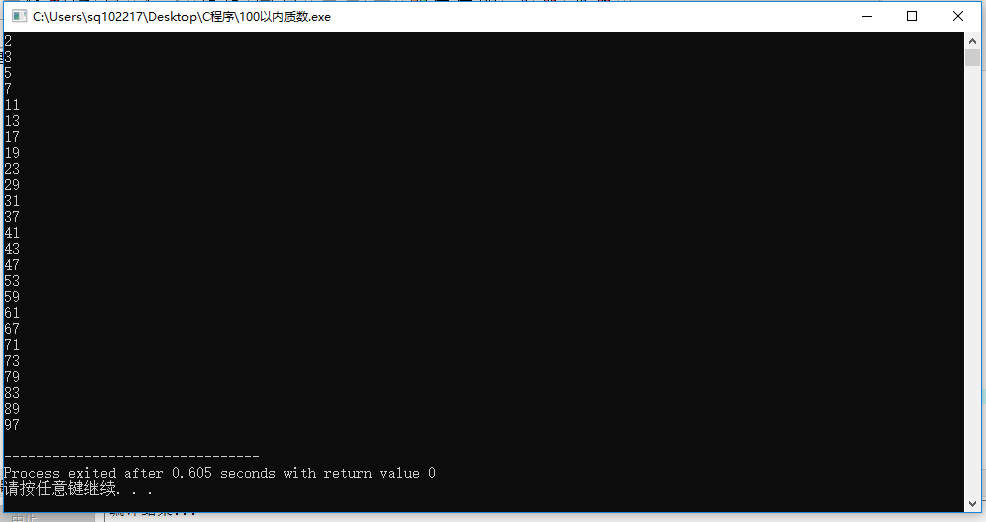
发现这些素数的排列不美观,于是我用setw()函数美化了一下这些数的排列方式,代码及运行结果如下:
#include<iostream> #include<math.h> #include<iomanip> using namespace std; int main() { int i,j,k,sign,m=0; for(i=2;i<=100;i++) { sign=1; k=sqrt(i); for(j=2;j<=k;j++) { if(i%j==0) { sign=0; break; } } if(sign) { for(i=2;i<=100;i++) { m++; if(m%6!=0) cout<<setw(5)<<i; if(m%6==0) cout<<setw(5)<<i<<endl; } } } }
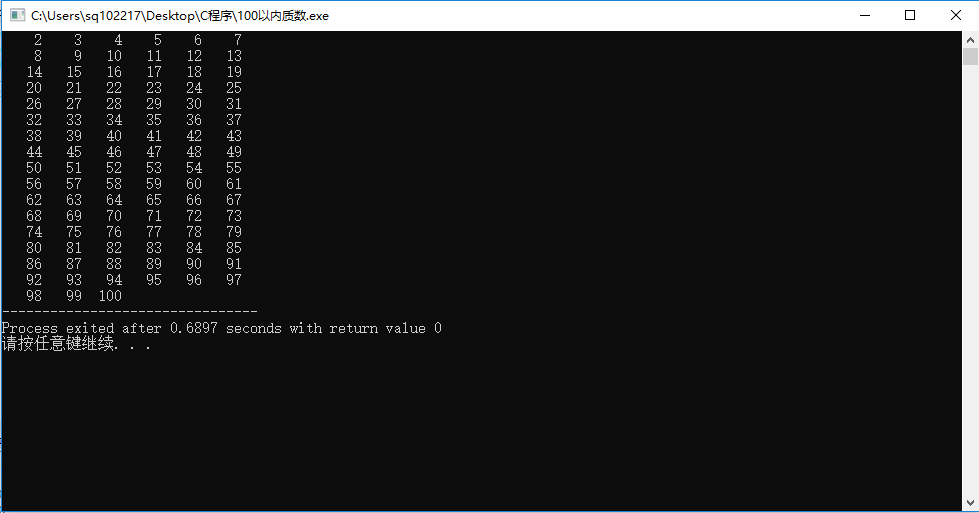 、
、
这个实验题我只用了两种循环语句,do...while和while语句相似,就不拿来占篇幅了。关于这些循环语句不做过多陈述。
2-32
在程序中定义一个整型变量,赋以1~100的值,要求用户猜这个数,比较两个数的大小,把结果提示给用户,直到猜对为止。
这个题目我才开始做的时候是自己在程序里定义了用户要猜的数,这样程序的重复利用率就比较低,先放源码:
-
# include<iostream> using namespace std; int main() { int guessnumber=26; int m=0; while(m!=guessnumber) { cout<<"please guess the number(1~100):"; cin>>m; if(m>guessnumber) cout<<"You guessed a big number"<<endl; else if(m<guessnumber) cout<<"You guessed a small number"<<endl; else cout<<"You has guessed the number!"<<endl; } }
考虑到程序的实用价值,进行了一次小升级:
-
# include<iostream> using namespace std; int main() { int guessnumber=26; int m=0; while(m!=guessnumber) { cout<<"please guess the number(1~100):"; cin>>m; if(m>guessnumber) { int i; i=m-guessnumber; if(i>=10) cout<<"Your guessnumber is too big"<<endl; else cout<<"Your guessnumber is very close,but it's still a little big"<<endl; } else if(m<guessnumber) { int j; j=guessnumber-m; if(j>=10) cout<<"Your guessnumber is too small"<<endl; else cout<<"Your guessnumber is very close,but it's still a little small"<<endl; } else cout<<"You has guessed the number!"<<endl; } }
两个程序运行结果如下:
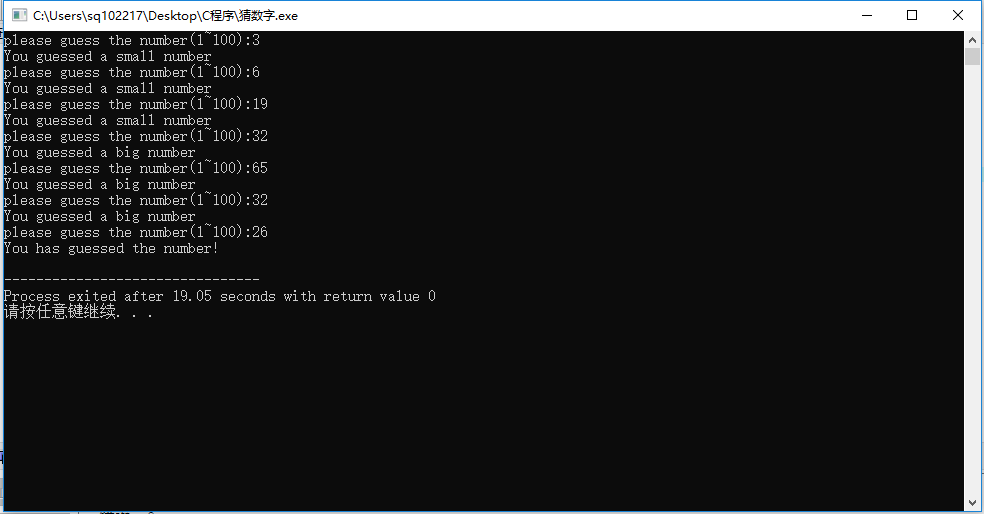
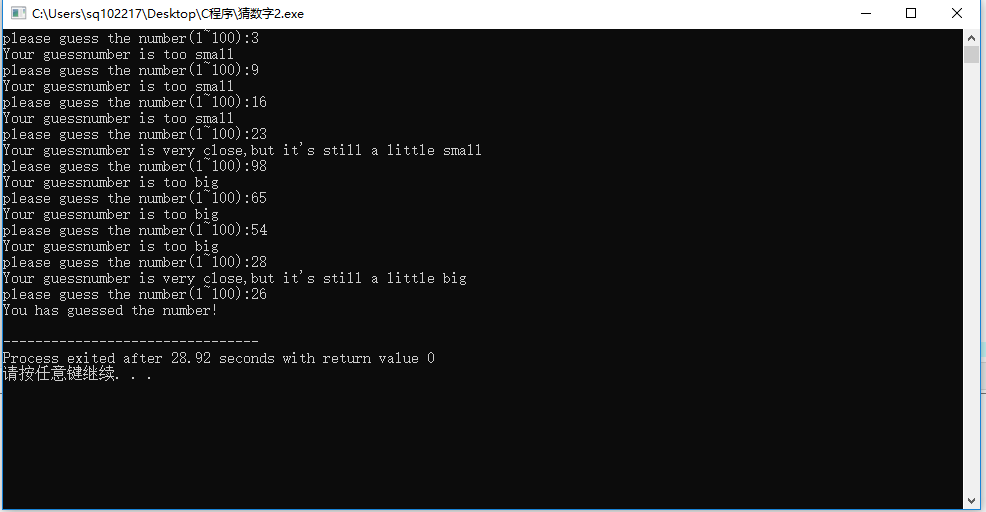
改变不大,但是从甲方考虑,显然2更适合。
在第三次升级的时候,考虑到程序的实用性,我加入了随机数,并允许在用户猜对数字后重开(清屏),給用户更多选择,下面是升级的代码及运行结果:
#include <cstdlib> #include <iostream> #include <ctime> using namespace std; int main() { srand(time(0)); int m= rand() % 100 + 1;//将随机数控制在1-100之间 int guessnumber;//用户输入的数字 char choice;//作出选择,是否继续 cout<< "Hello,master.My name is Xiao U."<<endl <<"I had a problems,can you help me?The method is simple."<<endl <<"Here's a bunch of numbers(0~100),but there's only one right,you should find the right number."<<endl <<"Starting right now"<<endl; do{ cout<< "Please enter a number: "; cin>> guessnumber; if( guessnumber >m) { cout<<"You guessed too high!,it's a pity"; } if( guessnumber <m) { cout<<"You guessed too low!,it's a pity!"; } if( guessnumber ==m) { cout<< "You get it!You have helped me solve the problem. HaHa,The number is: " <<m<<endl; cout<< "Do you want to play again?(Y/N):"; cin>>choice; if(choice== 'Y') { system("cls");//清空屏幕 cout<<"welcome back,master!"<<endl; continue; } else if(choice== 'N') { cout<< "bye,master."; break; } else { cout<< "You entered a wrong character! program will exit!"; break; } } }while(1); system("pause"); return EXIT_SUCCESS;//结束程序 }
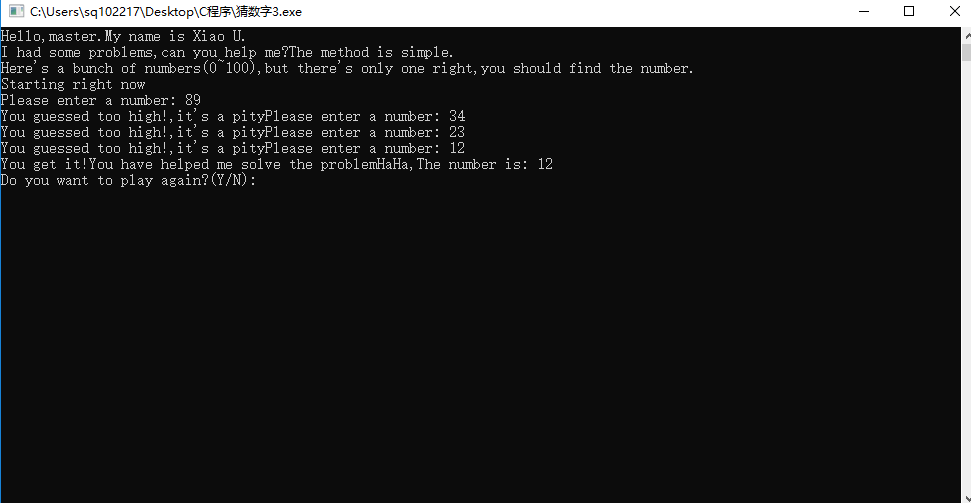
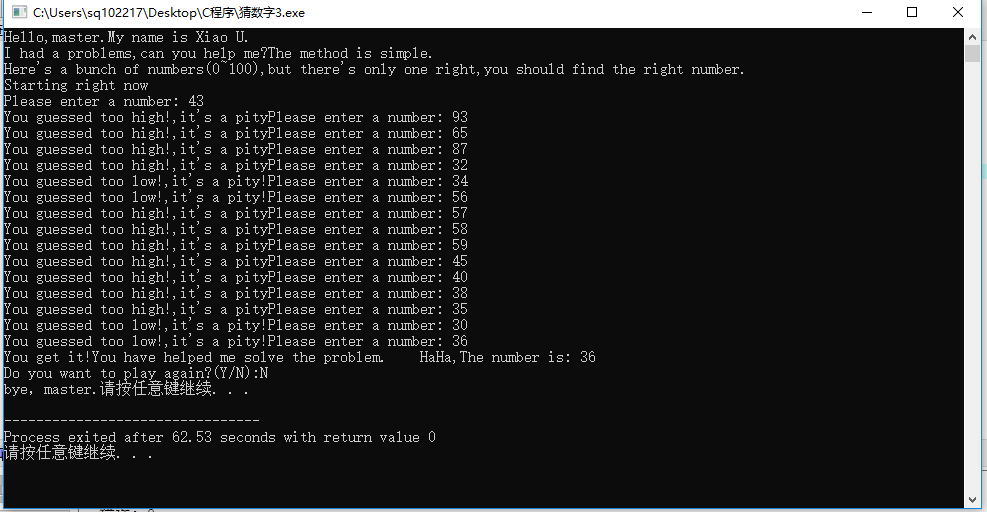
2-34
口袋中有红黄蓝白黑5种颜色的球若干个。没词葱口袋中取出3个颜色不同的球,问有多少种取法。
代码如下:
#include<iostream> using namespace std; int fac(int x) { int i,j; j=1; for(i=1;i<=x;i++) j*=i; return j; } int main() { int al; int a,b,c,d,e; cout<<"Please enter the number of each colour ball" <<endl; cout<<"red,yellow,blue,white,black:"; while(cin>> a>> b>> c>> d>> e) { al=fac(5)/fac(3)/fac(2)*a*b*c*d*e; cout<<"There are"<<al<<"methods to choose three kinds of the balls"; system("pause"); } return 0; }
运行结果:
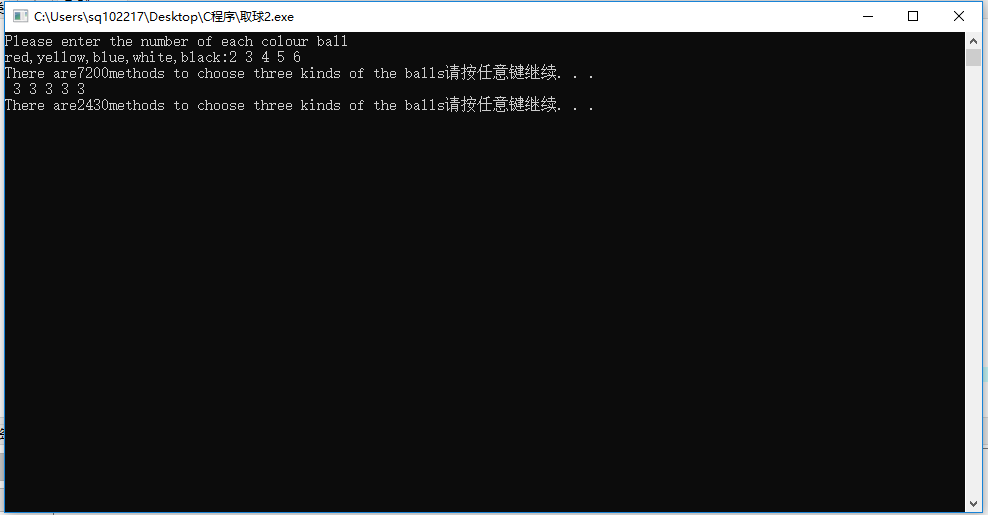
这一题我还写了一个拓展版,将5个球拓展到自定义的情况,但是不符合题目要求,就不放代码了~
实验反思:
- 2-28这是一个很简单的c++基础编程题,但是关于这一题还是有一些话说,作为一个伪小白,平时会阅读一些别人写的程序,关于if语句,个人很反对把复杂的难以理解的代码语句放到if的条件里面,这会严重影响到代码阅读,尽管很多时候在语法和逻辑上没有问题。if...else语句还要注意的一个问题就是如何用break和continue控制程序流程,这里不多说。关于switch语句,它的目的,学过c/c++的人应该都知道,就是为了实现深层嵌套的if...else逻辑,switch语句我觉得比较重要的就是定义变量方面的问题,switch结构只能在最后一个标号(这个标号可以是case或default)中定义变量。除此以外,没有特别需要说明的地方。
- 2-32关于最后升级版的程序,我查了关于srand()函数和清屏函数的相关内容,这个升级给用户提供了选择继续还是再开的选择,而且在程序实用性上也得到了加强,相比于前两个,显然这个价值更高。但是程序现在仍然存在一个bug,就是清屏后产生的随机数没有改变,还是和第一次一样,这样就达不到对这串代码的预期。由于这是课堂实验作业,时间有限,暂时先提交,在日后我会抓紧修改,如果有同学有好的想法,欢迎交流。还有就是,我想在这个程序内加一个计数器,记录重开的次数,有兴趣欢迎交流~


